Latest News
October 1, 2006
By Werner Greipl
An Alpine pilot finds a new way to move mountains.
Flying a helicopter in the Alps during winter is risky enough without loading up more than 400 pounds of dynamite and entrusting a colleague with lighting the sticks and throwing them out the window. Carrying all that TNT and somebody fumbling with a book of matches in the back always made me feel a little nervous.
I figured there had to be a better way to produce controlled avalanches. The suspicion that you might explode at any moment can be a powerful motivator, and in this case, nervousness was the mother of my invention. Avalanche Blast is an airborne method I helped develop to move snow off the mountain without the use of conventional explosives.
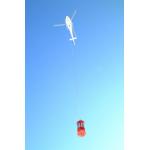 |
| Avalanche Blast |
Most avalanche mitigation is performed in one of two ways. The one I’m most familiar with as a pilot is airborne: you close the roads, fly the helicopter full of dynamite up to the snow-laden slope, light the dynamite, and throw it onto the mountainside. The other method is ground-based and is used extensively in North America. You either shoot artillery charges from the ground using surplus military cannons or rely on ski patrollers to toss lit sticks of dynamite over snow ledges.
In both cases, conventional charges do not always detonate when they hit the snow. In fact, roughly half of them are duds. That leaves unexploded dynamite or artillery charges on exposed slopes until springtime when they become hazardous to hikers. For this reason, the Italian government requires all unexploded charges to be retrieved within 24 hours. This puts people at greater risk by requiring them to trek up an avalanche-prone slope in winter to retrieve unexploded dynamite.
In addition to the obvious, simply transporting and storing explosives has its own risks. Because of this, some jurisdictions in the Alps need three weeks’ notice before granting a temporary permit, a difficult requirement when your work depends on the unpredictability of snowfall. Crafting a Model
I came up with the idea for a device that could deliver the same force without using explosives with Gabriel and Marco Kostner, partners in the Italian helicopter services firm, Elikos. Since I am also a mechanical engineer, it was up to me to design the device.
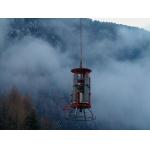 |
| Avalanche Blast |
The concept for Avalanche Blast uses a machine that hangs below the helicopter from a tether a safe distance from the cabin (see images 1 and 2 above). The device would fill a 1.5-meter (about 5 feet in diameter) meteorological balloon at the base of the apparatus with explosive gas. The gases (oxygen and hydrogen) are fairly safe to transport in separate canisters and do not require special permits. However, when mixed together inside the balloon at a critical proportion, the gases become volatile. Ignition by remote control will explode the balloon with a force equal to 2 to 4 kilograms (4.4 to 8.8 lbs.) of dynamite.
When I started considering modeling the device, I had some outdated software and started asking colleagues for recommendations. A friend sent me information about Alibre, and I got the free test version, Alibre Design Xpress, which you can simply download and use. Xpress is limited by the number of parts you can assemble, but after making just a few parts and small subassemblies, I found the system very easy to pick up; its parametrics were capable of handling the vision I had in mind.
My design would have movable mechanisms such as swinging frames with locks to hold the canisters of gas that could be quickly changed during a helicopter pit-stop. It also held a magazine of eleven latex balloons that would rotate around the base and automatically load a new balloon. Alibre Design allowed me to create the kinematic concept I had in mind.
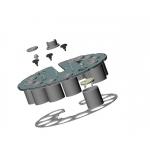
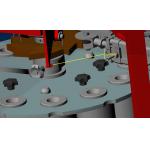
On the left is a model of the Avalanche Blast “magazine” produced with Alibre Design. The magazine can deliver eleven latex weather balloons. On the right is a close-up of the “magazine” with assembly instructions. Click images to enlarge.
Since this project had more than 300 model parts in the entire assembly, I upgraded to the full version of Alibre Design. At less than $1,000, I felt it was quite reasonably priced for the programming power it provides.
I had limited experience modeling solids, but Alibre Design’s commands were straightforward and it didn’t take me long to get used to it. I got a lot of good advice from Alibre’s German support desk representative Ralf Schroedter, who was very helpful and able to guide me when I needed to learn a new feature to draft a particularly difficult part. In all, I finished the whole design in just two weeks.
My philosophy was to keep the design as simple as possible to control costs. In the end, despite the fact that the Avalanche Blast machine contains hundreds of components, there were only three parts that required computer numeric controlled (CNC) milling. For those parts I simply exported the models to the Alibre milling module, and sent them to an outside fabricator.
My partners at Elikos tested the Avalanche Blast prototype for two seasons around ski resorts and mountain passes in Italy’s Dolomite Mountains. More than 500 balloons were fired. In contrast to conventional explosives, which might release snow 50 percent of the time, Avalanche Blast successfully moved snow at a rate of 80 percent.
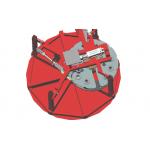 |
| Avalanche Blast |
< < The magazine rotates around the perimeter of the base of the apparatus.
The device can fill and fire 11 balloons on a single flight. The operator can load a new balloon in just 30 seconds. And the assembly makes for a quick refills on the ground. Hydrogen and oxygen canisters can be replaced in five minutes. In addition, the machine has many built-in safety interlocks, as well as a camera so the operator can monitor the device from the helicopter cabin. To view a video clip of Avalanche Blast in action, click here.
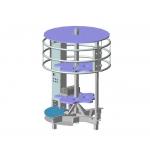 |
| Avalanche Blast |
> > The external frame of Avalanche Blast will hold 4 gas canisters, the balloon magazine, and the control panel.
Not only does Avalanche Blast eliminate the need for explosives in the helicopter cabin, but unexploded charges never remain behind on the mountainside-the balloon material is biodegradable. Compared to traditional methods, Avalanche Blast is safer, and more environmentally friendly, and it allows the pilot to concentrate on flying, which should calm everyone’s nerves.
After successful testing, my company sold the Avalanche Blast concept to T.A.S., a French manufacturer of ground-based avalanche control systems. It expects to make this safe and effective airborne method of triggering controlled avalanches commercially available soon.
Werner Greipl, an engineer and pilot, is general manager of Helicopter Travel Munich (HTM), operates Fun Flight und Helicopterdienste, and trains mountain search-and-rescue personnel internationally wih Heli Rescue Consult, GmbH. Send your comments about this article through e-mail by clicking here. Please reference “Avalanche, October 2006” in your message.
Alibre, Inc.
Richardson, TX
Elikos
Val Gardena, Italy
Heli Rescue Consult
Munich, Germany
Subscribe to our FREE magazine, FREE email newsletters or both!
Latest News
About the Author
DE’s editors contribute news and new product announcements to Digital Engineering.
Press releases may be sent to them via [email protected].






